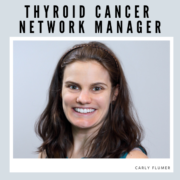Thyroid Cancer Empowerment Lead
The drip-drip-dripping of the sink in the radiology room echoed loudly in my brain as I waited for the pathologist. I just had a biopsy done for two spots on my neck—one suspected to be cancerous. “A nodule,” my primary care physician had previously explained at my annual physical. The radiologist had comforted me, casually saying, “I wouldn’t worry, though. There’s only a ten to fifteen percent chance.”
In just a few minutes, I would be given my fate.
In January 2017, I was diagnosed with thyroid cancer. I met my surgeon five months later. “What you have is called a papillarycarcinoma,” he said. “Doesn’t cancer come from tumors?” I thought. I looked up some terms in the National Cancer Institute’s Dictionary of Cancer
- Nodule – A growth or lump that may be malignant (cancer) or benign (not cancer)
- Carcinoma – cancer that begins in the skin or in tissues that line or cover internal organs
- Tumor – an abnormal mass of tissue that results when cells divide more than they should or do not die when they should. Tumors may be benign (not cancer) or malignant (cancer). Also called neoplasm.
The dictionary helped, but why weren’t these words explained to me by the doctors? It sounded like all the terms were being used interchangeably, and my brain was already feeling corrupted by the diagnosis—I was struggling to comprehend my diagnosis.
My bewilderment grew as I tried to understand how the thyroid hormones, T3 and T4, worked together with thyroglobulin (a biomarker), and the pituitary gland located in the brain. I understood what hypothyroidism vs. hyperthyroidism meant, but only because I knew the symptoms of each, and would be able to tell my doctor if I was experiencing any of them.
I was told by multiple doctors that I had the “good” type of cancer, and I felt hopeless and quite stupid for asking them to repeat what they had just said, or for asking them to explain a term or biological process in a different way.
Coincidentally, I had just started my fourth month of graduate school in a program focused on health communication—one of my first classes was writing for health communicators. That’s where I learned that, as of 2003, when the U.S. Department of Education measured health literacy of various populations across the country
- Only 53% had intermediate health literacy, or “having the skills necessary to perform moderately challenging activities.”
- 12% had proficient health literacy, or “skills necessary to perform more complex and challenging literacy activities.”
- Which means that more than 40% of the population is only able to understand the basics of their health.
It only gets worse for people living in poverty, the elderly, and racial minorities.
So how can we create health literacy equality among all populations?
The answer lies with patient advocacy and patient empowerment.
The doctor-patient relationship has changed significantly—for the better. Where once a patient relied on their doctor for information, to learn about a condition or a symptom, today, patients are finding this information online—and bringing their knowledge to appointments. They’re asking questions about their health and treatment paths. Some are even looking for answers about things that the doctor may not have heard of…yet!
As a health care professional, are you:
- Using terms that are patient-friendly or that are at grade level?
- Using pictures or diagrams to simplify complex concepts?
- Asking questions to make sure patients understand your instructions?
- Explaining test results, documents, brochures, etc.?
Most importantly, are you taking the time to listen to the patient’s concerns, and addressing them in a clear, understandable manner?
When doctors and health care providers take time to engage with them, patients feel more empowered to take charge of their health, and to become their own advocates. When the fearful become fearless is when real change happens.
Carly Flumer is a young woman who was diagnosed with stage I papillary thyroid cancer at the age of 27. She recently received her Master’s degree from Boston University in Health Communication and received her Bachelor’s from George Mason University in Health Administration and Policy. While being diagnosed with the “C” word at such a young age was a surprise, as it would be to anyone, she found strength, support, and inspiration in sharing her cancer journey on social media. As a result of her health outcome, she looks to advocate for other cancer patients through education, research, and health literacy.




